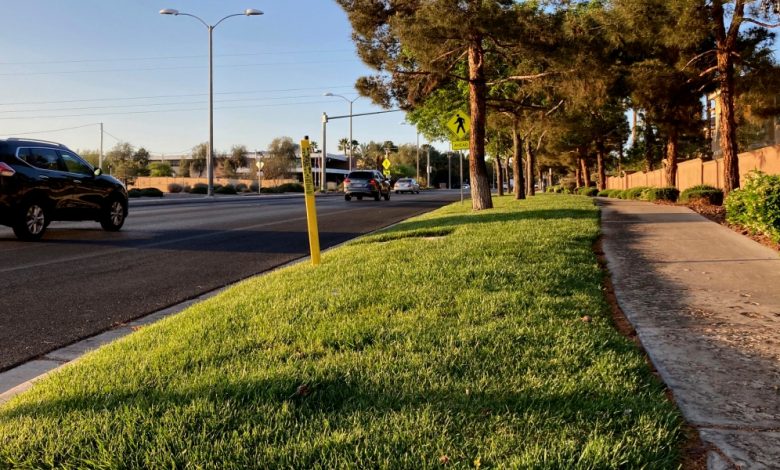Colorado River water authorities are tearing down grassy medians to fight climate change

A group of 30 agencies that provide water to homes and businesses in the western United States have pledged to rip up lots of ornamental grass to hold the water in the flooded Colorado River.
The agreement, signed Tuesday by water authorities in Southern California, Phoenix and Salt Lake City and elsewhere, shows an accelerating shift in the American West away from well-manicured grass, which has long been a totem of suburban life, taking root alongside roads and around wells and between office park walkways.
The Grass Removal Pledge targets lawns where people don’t work, such as in front of shopping malls, in street verges, or at neighborhood entrances. That doesn’t mean cities plan to rip up grass on golf courses, parks, or in backyards, though some homeowners may pay to voluntarily replace their lawns with more drought-resistant landscaping.
In addition to reducing ornamental grass by 30%, the agencies say they will increase water efficiency, add more water recycling and consider measures like changing how water is paid for to encourage savings.
“As we recognize that a clean, reliable water supply is critical to our communities, we can and must do more to reduce water use and increase reuse and recycling in our service areas,” the memo said.
The agreement didn’t detail the amount of water the agencies collectively pledged to save, but the cities account for about one-fifth of the Colorado River’s water use. The rest goes to agriculture.
“Cities – the 20% – cannot solve the math problem. But we can certainly help solve the problem,” said John Entsminger, general manager of the Southern Nevada Water Authority.
The commitments, which offer few details, could encourage agencies to offer landowners payments to uproot grass and replace it with drought-tolerant desert landscapes.
The pledge to cut 30% is the first time that water authorities across the region have collectively committed to a numerical benchmark targeting a specific type of water use. It comes as states scramble to reduce their consumption to meet calls from federal officials who say cuts are needed to maintain river levels and protect public health, food systems and hydropower.
The letter adds other signatories to an earlier agreement reached by five major water districts in August. Signatories include water boards in Albuquerque, Las Vegas and Denver.
Denver Water spokesman Todd Hartman said the city hopes to replace about 75 million square feet of unserviceable turf, but didn’t say how much water it would save. He said the agency hopes to roll out programs by 2024.
Regardless of the savings, the new commitments will mean far less environmental protection than is needed to keep water flowing through the Colorado River and preventing its major reservoirs from shrinking to dangerously low levels.
Phoenix wants its program to run by spring; It will be the first time the city has paid people to rip up grass, said Cynthia Campbell, the city’s water resources management consultant. Even without a program, many people removed weed. In the 1970s, about 80% of homes had grass covering most of their property; today it’s 9%, but that doesn’t include the sprawling suburbs outside the city limits, she said.
Like others, she stressed that cities’ water savings would not solve the river’s problems.
“In the entire Western United States, there isn’t a municipal conservation effort that can offset the water that needs to be conserved,” she said. But “we give as much as we can until it hurts.”
The letter does not include commitments from agriculture, which uses about 80% of allotted water in the seven states that rely on the river – Arizona, California, Colorado, Nevada, New Mexico, Utah and Wyoming.
Lake Powell and Lake Mead, the river’s two main reservoirs, are each about a quarter full.
In June, US Bureau of Reclamation Commissioner Camille Touton warned states they must drastically reduce their consumption, but amid rows over who would shoulder what burden, officials didn’t respond to her call. The bureau has since offered different payments to water districts to reduce their consumption by leaving agricultural fields unplanted or asking city dwellers to use less at home.
Proposals for some of that money are due November 21st.
The Metropolitan Water District in Southern California, which supplies water to about half of California’s residents, in October asked cities and water boards in its area to ban the addition of new ornamental grass in commercial precincts, public spaces and neighborhoods. The board also urged authorities to halt irrigation and consider removing grass that has already been planted.
Southern Nevada has for decades used a mix of monetary incentives and fines to discourage grass irrigation and restrict both functional and non-functional lawns. The agreement has little impact on the area, as a state law passed last year mandates that 100% of non-functional turf in the Las Vegas area be demolished by 2026.
Utah last year enacted a statewide conservation program that included a $5 million peat removal incentive targeting ornamental grasses on public property. However, some municipalities maintain ordinances enacted for aesthetic reasons that prohibit residents from substituting drought-tolerant landscaping for grass.
__
Ronayne reported from Sacramento, California. AP writer Thomas Peipert contributed coverage from Denver.
Our new weekly Impact Report newsletter will examine how ESG news and trends are shaping the roles and responsibilities of today’s leaders – and how best to address these challenges. Subscribe here.



